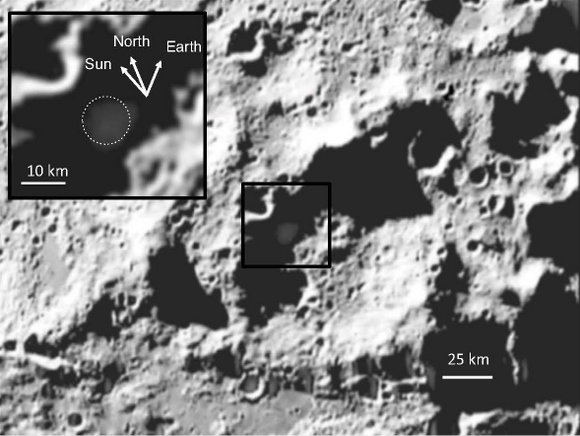After a year of analysis, the LCROS team published the surprising data of the materials that were ejected from the crater when the projectile hit it: in addition to abundant water, materials including carbon monoxide, sulfur dioxide, mercury and silver were found that indicate a cometary origin

About a year ago, NASA successfully crashed a Centaur rocket into the Kabeus Crater, a permanently shadowed crater in the south pole region of the Moon. A companion spacecraft called LCROSS (Lunar Crater Observation and Sensing Satellite) followed the projectile and monitored the ejecta cloud to see if materials were released from the dark and unexplored region of the moon.
This week the LCROSS team published its findings, after a year of analysis. Principal Investigator Tony Colpert told Universe Today that LCROSS discovered water and much more.” The 'much more' is actually no less interesting than the water, and the combination of the water and the other volatile substances we saw is even more interesting and puzzling.
The 2,400 kg Centaur rocket created a crater 25-30 meters in diameter, and the LCROSS team estimated that 4-6 tons of debris appeared from the dark crater into LCROSS's sunlight-lit field of view.
The impact crater created low-angle and high-angle emission clouds. The LCROSS team was able to measure large amounts of water in several forms - water vapor, and more importantly - water ice. Ice is important because we are talking about different levels of concentration.
A combination of measurements in the near infrared, ultraviolet and visible spectrum revealed about 155 kg of water vapor and water ice blown from the crater and detected by LCROSS. Colpert and his team estimate about 5.6% of the total mass inside Kabaus Crater, plus or minus 2.9% may be contributed by ice. The ice blocks are also important because they indicate conditions in which the water could crystallize into glaciers, and thus it is easy to know how the ice was formed. Two types of hydroxyls were also discovered, which is no less exciting according to Culpert. "This indicates that OH can be formed from degenerates." said.
The important addition came at this point. Among the LCROSS instruments, which as we know also crashed into the crater shortly after, and the observations of the LRO spacecraft and in particular a device known as LAMP, it turned out that the most common volatile substance in terms of mass is carbon monoxide, then water, followed by hydrogen sulfide. After that the materials were in the following order: nitrogen dioxide, sulfur dioxide, methane, formaldehyde, probably also ethylene, ammonia and even mercury and silver. "The concentration of ammonia and methane is similar to the concentration of water, something we expect to see in comets." According to Colpert, the fact that concentrations of nitrogen dioxide were found in a larger amount than water, and the very existence of the cupric hydrogen, shows a large amount of processes taking place inside the crater itself.
"Where does the energy come from to carry out chemistry at a temperature of 40-50 degrees Kelvin? Is it from the cosmic radiation, the solar wind whose photons find their way in or an electric potential that is in the seam between dark and light areas? We don't know, it's circumstantial evidence. We have some data but no way to make sense of it. There are materials there that appear to be of cometary origin, similar to the processes of cold nuclei in interstellar space."
According to Culpert, most of these substances are surprising, especially carbon monoxide, mercury, and in particular methane and molecular hydrogen. "He has a lot of questions because of these inventions." said.

8 תגובות
According to the advertisement, they are not ready to bring a six-pack of water from the grocery store, so now you want them to bring water from the moon?
Why don't we actually blow up the moon, why do we need it?
There is a mistake in the fifth paragraph, where the complex ion is: hydroxide, not hydroxyl,
(line 4).
So smashing another missile or actually an atomic bomb will lift a lot more material into the air. When you think about it, it will be easier to see what the moon is made of if we separate it completely into its atoms in an explosion so... as long as they film it for everyone and show it on Discovery or the movie Armageddon 2, surely Hollywood will pay something for the footage2
Everything catches up to get a little more knowledge, and space photographs. These Americans are irresponsible.
Usually the moon has an image of a dry and arid block of rock floating in space, amazing.
Maybe the wise men forgot these materials inside the rocket they smashed to the moon.
A comet that collides and creates a crater will scatter cometary materials. I didn't understand the confusion